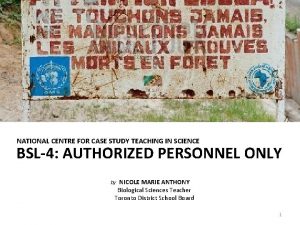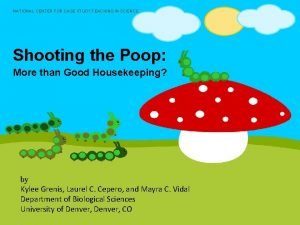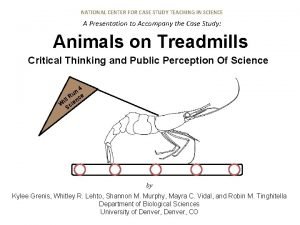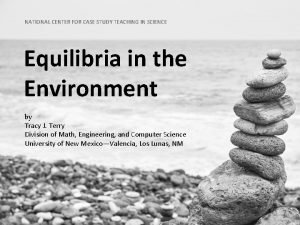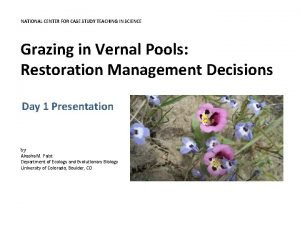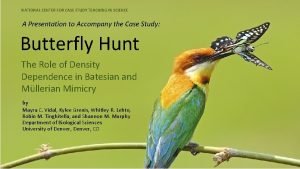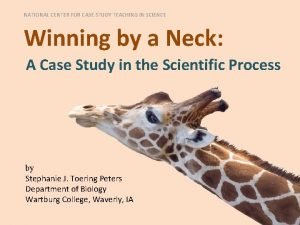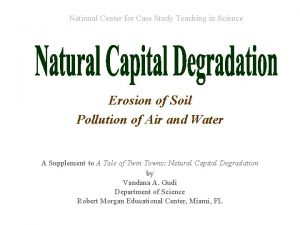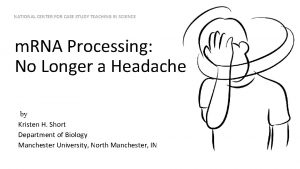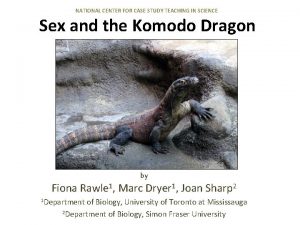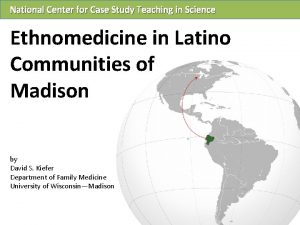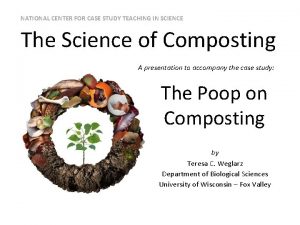NATIONAL CENTER FOR CASE STUDY TEACHING IN SCIENCE




















- Slides: 20

NATIONAL CENTER FOR CASE STUDY TEACHING IN SCIENCE A Presentation to Accompany the Case Study: The Polar Bear of the Salt Marsh? Beth A. Lawrence Natural Resources & the Environment; Center for Environmental Science & Engineering University of Connecticut, Storrs, CT Christopher R. Field National Socio-Environmental Synthesis Center (SESYNC) University of Maryland, Annapolis, MD 1

Learning Objectives • Integrate key concepts related to rising sea levels on coastal wetlands: plant adaptations, vegetation zonation, sea level rise, marsh migration. • Interpret data to draw conclusions about environmental change. • Evaluate alternative management decisions. 2

Where do salt marshes occur? Where land meets the sea, moderately sloped coastlines, and temperate zones. Salt marshes: green; mangrove forests: orange 3

Why are salt marshes important? • Very productive ecosystem • Sequester lots of carbon (carbon sink) • Provide habitat: shellfish, fisheries, threatened & endangered species • Improve water quality • Remove nitrogen via denitrification • Reduce storm impacts • Reduce erosion 4

Why are salt marsh sparrow nests drowning? Bride Brook Salt Marsh, CT USA 5

Salt Marsh Plant Zonation 6

Sea-Level Rise (SLR) NASA video: http: //www. space. com/30379 -nasa-sea-level-rise-model-video. html 7

Will salt marshes migrate? What might impede salt marsh migration? Wheeler Marsh, CT Barn Island, CT Old Saybrook, CT 8 Images from Google Maps

So is the salt marsh sparrow the polar bear of the salt marsh? Compare and contrast. ? 9

You own a $1. 5 million house in Old Saybrook in the marsh migration zone. What do you do in the face of sea-level rise? Conduct outside research on assigned sea-level response strategy. A. B. C. D. E. Beach nourishment Sea wall construction Conservation easement Sell property Put house on stilts (adaptation) Create a bullet list of pros and cons, and bring to class. 10

Impacts of climate warming on terrestrial ectotherms across latitude (Deutsch et al. , 2008) Which latitudinal region experiences the greatest magnitude of temperature variation? A) Tropical B) Dry C) Temperate D) Continental E) Polar 11

Impacts of climate warming on terrestrial ectotherms across latitude (Deutsch et al. , 2008) Which latitudinal region contains species that are at the greatest risk of population decline or extinction due to climate warming? A) Tropical B) Dry C) Temperate D) Continental E) Polar 12

Why may ectotherms be more vulnerable to climate change than endotherms? Discuss with your group and come up with at least 3 reasons. 13

Why may ectotherms be more vulnerable to climate change than endotherms? 1) They do not have internal mechanisms for thermoregulation. 2) Most species are TSD so their populations will end up as all male or all female (See Jensen et al. , 2018 on green sea turtles in Australia. ) 3) Most species exist along the equatorial region and that is predicted to have the greatest loss of species diversity (Roll et al. , 2017). (Graph by J. Wyneken & B. Tezak) Global distribution of reptile species 14

How do we determine which species are facing the greatest risk of population decline/extinction? Calculate the ‘warming tolerance’. WT = CTmax - Thab Calculate the ‘thermal safety margin’. TSM = Topt - Thab Wood frog – (Lithobates sylvaticus) 15

Warming Tolerance Wood frog data CTmax = 29 C CTmin = -6 C Topt = 22 C Utqiagvik, Alaska – Average maximum recorded temperature: 8. 3 C Average minimum recorded temperature: -21. 8 C Kenosha, WI – Average maximum recorded temperature: 26. 3 C Average minimum recorded temperature: -0. 9 C WT = CTmax - Thab WT (Utqiagvik, Alaska) = 29 -8. 3 = 20. 7 C WT (Kenosha, WI) = 29 -26. 3 = 2. 7 C Wood frog – (Lithobates sylvaticus) 16

Thermal Safety Margin Wood frog data CTmax = 29 C CTmin = -6 C Topt = 22 C Utqiagvik, Alaska – Average maximum recorded temperature: 8. 3 C Average minimum recorded temperature: -21. 8 C Kenosha, WI – Average maximum recorded temperature: 26. 3 C Average minimum recorded temperature: -0. 9 C TSM = Topt - Thab TSMAlaska = 22 -8. 3 C = 13. 7 C TSMWI = 22 -26. 3 C = -4. 3 C Wood frog – (Lithobates sylvaticus) 17

What species are at risk in our area? To do: • Pick a North American species that can be found across a 20 degree latitudinal range or further • Look up the minimum and maximum temperatures your species can survive in. • Look up your species optimal temperature • Find a map of the distribution of your species • Select a location along the northern range and a second location along the southern range and find the maximum/minimum ambient temperatures Calculate the ‘warming tolerance’ of your species. WT = CTmax - Thab Calculate the ‘thermal safety margin’ of your species. TSM = Topt - Thab 18

What are four ways animals may mitigate the negative effects of climate warming? How do they differ from one another? Adaptation – a population’s shift in genotypic and phenotypic frequencies in response to environmental change Acclimation – an individual’s physiological response to environmental change 19

What are four ways animals may mitigate the negative effects of climate warming? How do they differ from one another? Dispersal – movement of individuals from one locality to another (can refer to diffusion, jump dispersal or secular dispersal) Behavioral plasticity – an individual’s behavioral modification to shift daily activities to a more optimal period of the day. 20
 National centre for case study teaching in science
National centre for case study teaching in science National center for case study teaching in science
National center for case study teaching in science National center for case study teaching in science
National center for case study teaching in science National center for case study teaching in science
National center for case study teaching in science National center for case study teaching in science
National center for case study teaching in science National center for case study teaching in science
National center for case study teaching in science National center for case study teaching in science
National center for case study teaching in science Best worst and average case
Best worst and average case Foxmeyer erp failure case study
Foxmeyer erp failure case study Why science is my favourite subject
Why science is my favourite subject Difference between traditional teaching and micro teaching
Difference between traditional teaching and micro teaching Fspos
Fspos Typiska novell drag
Typiska novell drag Tack för att ni lyssnade bild
Tack för att ni lyssnade bild Ekologiskt fotavtryck
Ekologiskt fotavtryck Shingelfrisyren
Shingelfrisyren En lathund för arbete med kontinuitetshantering
En lathund för arbete med kontinuitetshantering Adressändring ideell förening
Adressändring ideell förening Tidböcker
Tidböcker A gastrica
A gastrica Densitet vatten
Densitet vatten
